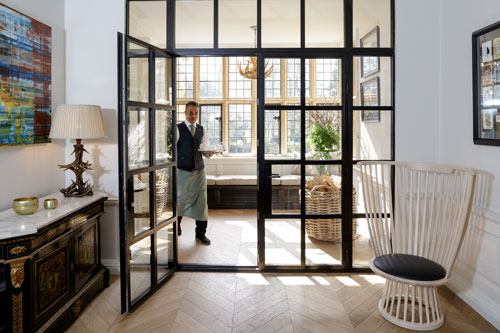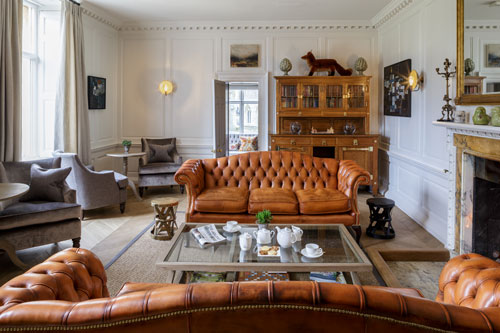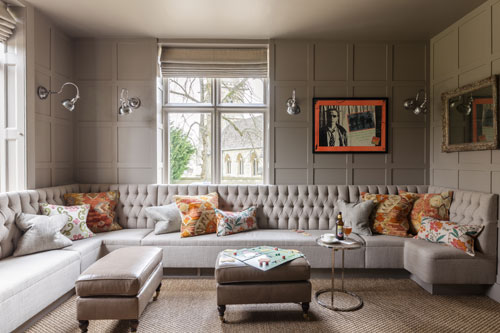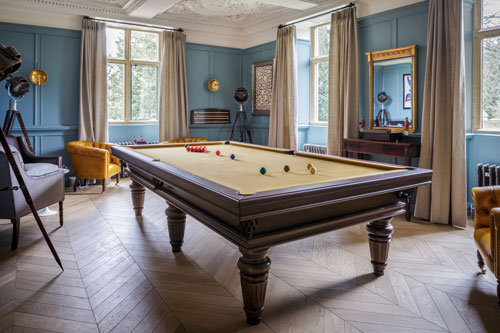Hotel design: Slaughters Manor House
This ancient manor, which dates back to the 17th century, has been reborn with a fresh, contemporary look that is still elegant and perfectly complementary to the Cotswolds countryside. Janet Harmer reports
Today, the owner is Andrew Brownsword Hotels, which bought the property under the name of Lower Slaughter Manor in 2011, together with three other country house hotels following the administration of Von Essen hotels off a guide price of £32.5m.
The group, headed by Andrew and Christina Brownsword, owns 15 hotels including Gidleigh Park in Chagford, Devon, the Bath Priory and the Imperial hotel, Torquay, as well as the ABode brand of city centre hotels.
Earlier this year, Lower Slaughter Manor closed for a three-month remodelling of the ground floor and a refurbishment, which has introduced a more current interior, marking a shift from the more traditional style of Brownsword's other country house hotels.
The bedrooms and three-AA-rosette restaurant on the lower ground floor, where head chef Nik Chappell oversees the menu, were left untouched.
The reopening of the property in March, with general manager Stuart Hodges at the helm, was marked by a name change to Slaughters Manor House. The four- red-AA-star hotel has a total of 19 bedrooms - 11 in the main house and eight in the coach house - with room rates starting at £176.
Another former Von Essen property, the Slaughters Country Inn, a village pub with 31 bedrooms, is located opposite SlaughterManor House.
Design inspiration
The Brownswords are heavily involved in overseeing the interior design of all their hotels, and Slaughters Manor House was no different. They worked closely with Rachel Morris of Bath architects and designers Simon Morray-Jones with the aim of restoring the character of the building and exposing architectural details that had been covered up.
The idea was also to introduce a more relaxed interior to what is a grand manor house. This has been created with the use of a lighter colour palate, with Andrew Brownsword's personal art collection adding an eclectic and at times irreverent feel.
A revitalised layout with well-defined rooms that are more appropriate for today's guests has helped to breathe new life into the property, turning once-redundant rooms into vibrant spaces, bringing atmosphere to the hotel.
Morris says the brief was to create a "home from home" for guests, with a fresh, timeless new look that enhances its historic features.
"The stone acorns topping the gate pillars were the starting point; they're a nod to the countryside life epitomised by the Cotswolds setting and from there a contemporary interpretation began to evolve," she explains.
"Natural and tactile materials epitomise luxury, comfort and glamour. Evocative colours create mood and define special places; and brass, leather and cut glass suggest tradition."
The entrance hall
New glass double doors have opened up the entrance, and the first impressions are of a light, uncluttered space with clean lines emphasised by the contemporary chevron oak parquet flooring from Pietra Wood & Stone, which runs throughout the ground floor.
The neutral colour scheme - leading to more colourful reception rooms - features walls in Paintfinity, an eco-friendly paint that can be colour-matched to any other paint range. In the entrance hall the shade is based on All White from Farrow & Ball.
The juxtaposition of the old and the new is provided by the contemporary white fan chair, which sits opposite a traditional lacquered sideboard from the Brownswords' personal collection. Bespoke Bampton soft chairs are covered in Abruzzi fabric in marble from Designers Guild.
The library
The heavy, dark furniture, reminiscent of an aged aunt's home, have been replaced by lighter, comfortable seating, dominated by twin Chesterfields on either side of the marble fireplace in hand-coloured tan leather from Fleming & Howland's Edmund Burke range.
The sofas are complemented by the same Bampton chairs as in the entrance hall, but this time covered in a vintage silk velvet called Glanville in Pebble from Designers Guild, and a herringbone woollen tweed by Bute in the Lewis range, colour 0913.
n oak dresser provides a home for books and board games, while the windows have been given a simple treatment with a linen fabric (Legacy SC027-10) by Sheila Coombes from Rossiters of Bath. To provide continuity and ensure the impressive gardens are not concealed by heavy drapes, the same material is used for the curtains in the Billiards Room and the Oxford Room, and the blinds in the lounge.
The snug
Located just off the library, the snug, previously an unloved and rarely used conference room, has been given a new lease of life. Now it provides a quiet corner to curl up in with a book or a space for sports fans to retreat to with its large, wall-mounted TV. It is also proving to be a favourite room for adults with children.
A linen weave called Paveley in stone from Jane Churchill is used to cover the bespoke banquette seating from Bampton Design, while splashes of colour have been introduced in the cushions and the Sex Pistols print from the Brownsword's private collection.
The wall panelling is painted in a shade from Paintfinity, based on Farrow & Ball's Charleston Gray, while the sisal bubble weave carpet in honey is from Alternative Flooring.
The bar
The new bar has injected a new focal point. It fills the space between the entrance hall and lounge, and was created in conjunction with Sipsmith gin. Although distilled in Chiswick in London, Sipsmith's master distiller Jared Brown lives in Lower Slaughter, and many of the botanicals used in the gin originally came from his own garden.
The bar, featuring a brass top, is accompanied by chairs from Bampton Design, covered in Designers Guild's Cassia velvet in Blossom.
The lounge
The lounge is now a world away from what it once was, with pastel walls enlivened with eclectic splashes of colour provided by the furnishings and artwork. Paintfinity's shade, based on Farrow & Ball's Middleton Pink, provides the backdrop, while a leather-edged sisal rug tops the oak chevron floor.
Bespoke sofas and chairs from Bampton Design are covered in a selection of Designers Guild fabrics, including Glenville in Pebble and Cassia cotton velvet in Current, alongside the previously used Lewis fabric from Bute.
The contemporary white chairs and wooden chests belong to the Brownswords. The lounge is busy throughout the day, serving morning coffees and afternoon teas as well as light snacks with cocktails at night.
The billiards room
This is another room that didn't get a great deal of use in its former life as a private dining room and events space. But now, with a traditional oak and tan felt pool table from Luxury Pool Tables, the room regularly buzzes with activity. A group of local residents frequently come in for a game and G&Ts.
Oxford tub chairs in hand-coloured gold leather from Fleming & Howland lend a clubby feel, while the freestanding studio floor lamps from Eichholtz add a theatrical touch.
The wall panelling is again painted in a shade from Paintfinity, this time based on Farrow & Ball's Berrington Blue.
The Oxford room
Previously known as the Sir George Whitmore room after the founder of the building, this private dining room has been renamed as the Oxford room to reflect the prints of the city that now hang on the walls.
A more muted colour scheme has been selected here, and up to 24 guests can be seated around the oak table from Coach House. The Provencal dining chairs, covered in Osborne & Little's Pebble faux suede fabric (F5972-04) on the seat and a matching grey leather on the back, are from Bampton Design.
Future plans
The Brownswords are delighted with the results of the refurbishment. The friendly and accessible vibe it has created has been well received by both the hotel guests as well as the residents of Lower Slaughter.
Stephanie Hocking, chief executive of Andrew Brownsword Hotels, said: "The
investment at the Slaughters Manor House has delivered beyond expectations and sales are above the targets set prior to refurbishment."
Looking ahead, the focus for the group will be on undertaking improvements at its newly acquired properties - along with the Imperial in Torquay, Devon, ABH has also recently bought the Old Swan and Minster Mill in Minster Lovell, Oxfordshire.
Suppliers
Wall paint Paintfinity www.paintfinity.co.uk
Oak wood floor Pietra Wood & Stone www.pietrawoodandstone.com
Sisal flooring Alternative Flooring www.alternativeflooring.com
Seating Bampton Design www.bamptondesign.co.uk
Chesterfield sofas Fleming & Howland www.chesterfields1780.com
Fan Chair Tom Dixon www.tomdixon.net
Velvet fabrics Designers Guild www.designersguild.com
Woollen tweed fabric Bute www.butefabrics.com
Sheila Coombes linen curtains Rossiters of Bath www.rossitersofbath.com
Private dining table Coach House www.coachhouse.com
Pool table Luxury Pool Tables luxury-pool-tables.co.uk
Studio floor lamps Eichholtz www.eichholtz.com
Continue reading
You need to be a premium member to view this. Subscribe from just 99p per week.
Already subscribed? Log In















